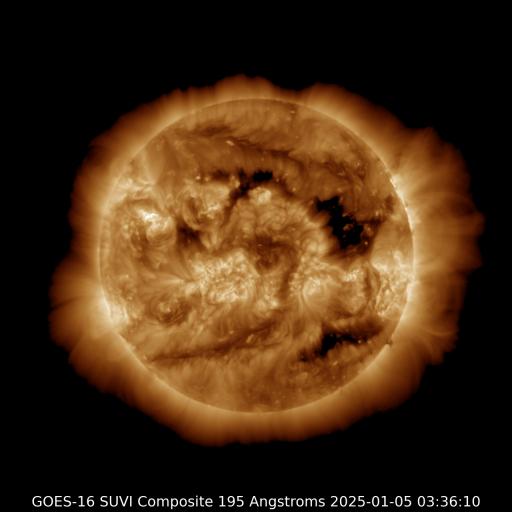Viewing archive of Friday, 26 January 2018
Daily bulletin on solar and geomagnetic activity from the SIDC
Issued: 2018 Jan 26 1230 UTC
SIDC Forecast
Solar flares
Quiet conditions (<50% probability of C-class flares)
Geomagnetism
Active conditions expected (A>=20 or K=4)
Solar protons
Quiet
| 10cm flux | Ap | |
|---|---|---|
| 26 Jan 2018 | 070 | 012 |
| 27 Jan 2018 | 069 | 015 |
| 28 Jan 2018 | 069 | 008 |
Bulletin
Solar activity was at very low levels. The Sun is spotless. No earth-directed coronal mass ejections (CMEs) were observed in available coronagraphic imagery. The greater than 10 MeV proton flux was at nominal levels.
Solar activity is expected to remain at very low levels.
Solar wind became enhanced as the wind speed, initially steady at 420 km/s, started a gradual increase around 01UT to values near 500 km/s by the end of the period. Bz oscillated between -6 and +7 nT (DSCOVR). The interplanetary magnetic field (IMF) was mostly directed towards the Sun. A small negative equatorial coronal hole (CH) is transiting the central meridian.
The geomagnetic field was at quiet to unsettled levels and is expected to remain so during the next few days. An active episode is possible from the moderate speed wind streams associated with the observed CHs.
Today's estimated international sunspot number (ISN): 000, based on 09 stations.Solar indices for 25 Jan 2018
| Wolf number Catania | 000 |
| 10cm solar flux | 070 |
| AK Chambon La Forêt | 015 |
| AK Wingst | 010 |
| Estimated Ap | 009 |
| Estimated international sunspot number | 000 - Based on 13 stations |
Noticeable events summary
| Day | Begin | Max | End | Loc | Strength | OP | 10cm | Catania/NOAA | Radio burst types | |
|---|---|---|---|---|---|---|---|---|---|---|
| None | ||||||||||
Provided by the Solar Influences Data analysis Center© - SIDC - Processed by SpaceWeatherLive
All times in UTC
Current data suggests there is a slight possibility for aurora to appear at the following high latitude regions in the near future
Edmonton, AB, Gillam, MB, Saskatoon, SK, Whitehorse, YT, Yellowknife, NTAnchorage, AK, Fairbanks, AK, Juneau, AK
Latest news
Latest forum messages
Support SpaceWeatherLive.com!
A lot of people come to SpaceWeatherLive to follow the Sun's activity or if there is aurora to be seen, but with more traffic comes higher server costs. Consider a donation if you enjoy SpaceWeatherLive so we can keep the website online!

Latest alerts
06:30 UTC - Type II Radio Emission
Begin Time: 08/04/2025 05:53 UTC Estimated Velocity: 456km/sec.
05:15 UTC - Hemispheric Power Index
The OVATION model predicts the Hemispheric Power Index to reach 50GW at 06:02 UTC
00:55 UTC - Coronal hole
A southern hemisphere coronal hole is facing Earth. Enhanced solar wind could arrive in ~3 days
Monday, 7 April 2025
20:45 UTC - Geomagnetic activity
Active geomagnetic conditions (Kp4) Threshold Reached: 20:39 UTC
17:33 UTC - Hemispheric Power Index
The OVATION model predicts the Hemispheric Power Index to reach 51GW at 18:18 UTC
Space weather facts
| Last X-flare | 2025/03/28 | X1.1 |
| Last M-flare | 2025/04/05 | M1.0 |
| Last geomagnetic storm | 2025/04/06 | Kp5 (G1) |
| Spotless days | |
|---|---|
| Last spotless day | 2022/06/08 |
| Monthly mean Sunspot Number | |
|---|---|
| March 2025 | 134.2 -20.4 |
| April 2025 | 151.3 +17.1 |
| Last 30 days | 135.2 -4.5 |




